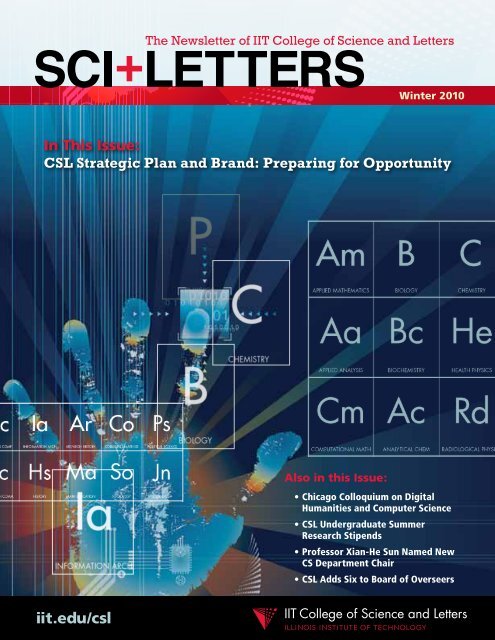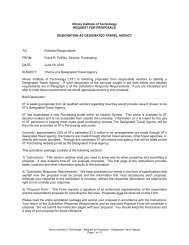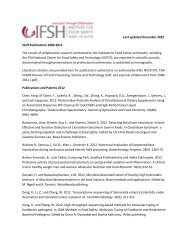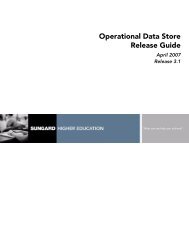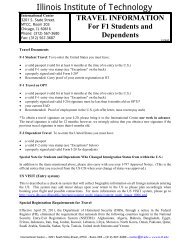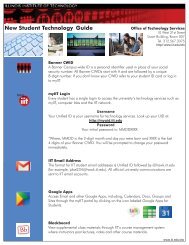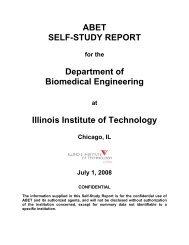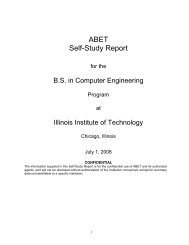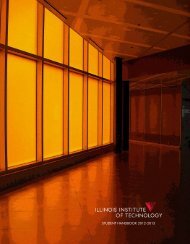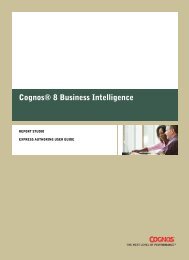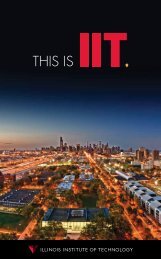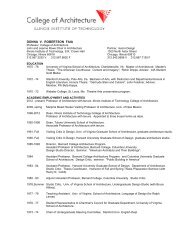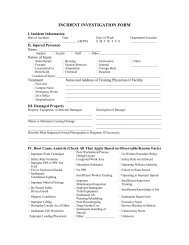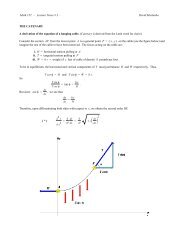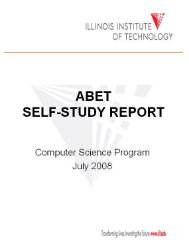Download - Illinois Institute of Technology
Download - Illinois Institute of Technology
Download - Illinois Institute of Technology
Create successful ePaper yourself
Turn your PDF publications into a flip-book with our unique Google optimized e-Paper software.
The Newsletter <strong>of</strong> IIT College <strong>of</strong> Science and Letters<br />
Winter 2010<br />
In This Issue:<br />
CSL Strategic Plan and Brand: Preparing for Opportunity<br />
Also in this Issue:<br />
• Chicago Colloquium on Digital<br />
Humanities and Computer Science<br />
• CSL Undergraduate Summer<br />
Research Stipends<br />
• Pr<strong>of</strong>essor Xian-He Sun Named New<br />
CS Department Chair<br />
• CSL Adds Six to Board <strong>of</strong> Overseers<br />
iit.edu/csl
Dear Friend <strong>of</strong> CSL:<br />
It has been a year since I wrote to you for the first time as incoming dean <strong>of</strong> the college—and what a<br />
year this has been!<br />
In the past 12 months, we have seen an unprecedented collapse <strong>of</strong> financial markets and the economy, a major<br />
shift in the national political base <strong>of</strong> power, the beginnings <strong>of</strong> an uncertain economic recovery, and major<br />
discussions on international policy, national health care, and energy and environmental policy—just to start.<br />
The unforeseen nature and complexity <strong>of</strong> these events and issues underline a point in last year’s letter—the<br />
need “to train future leaders who not only excel in their chosen disciplinary or pr<strong>of</strong>essional areas, but are<br />
educated in a much broader sense with an awareness <strong>of</strong> the needs and complexity <strong>of</strong> the modern world.”<br />
This thought is incorporated in one <strong>of</strong> the major goals <strong>of</strong> the recent IIT Strategic Plan, Many Voices, One Vision:<br />
to distinctively define the IIT graduate as one whose education at IIT combines discipline-specific expertise<br />
equivalent to that at the very best private technological universities, with exposure to the knowledge and<br />
mindsets <strong>of</strong> the broad range <strong>of</strong> disciplines and pr<strong>of</strong>essions at IIT. The College <strong>of</strong> Science and Letters is playing a<br />
key role in the further development and implementation <strong>of</strong> the definition <strong>of</strong> the distinctive IIT graduate. I look<br />
forward to keeping you informed as we progress in this direction and welcome your thoughts and input.<br />
In parallel with the IIT strategic planning process, the college has also carried out its own planning. A working<br />
group <strong>of</strong> faculty and staff from my <strong>of</strong>fice produced a draft document in April 2009.<br />
Vision and Mission<br />
The most important pieces <strong>of</strong> any plan are the vision and mission statements.<br />
The CSL vision statement reads:<br />
Winter 2010<br />
IIT’s College <strong>of</strong> Science and Letters will be a model <strong>of</strong> scholarship, discovery, invention, and education in the<br />
humanities and sciences in a university focused on science, technology, and the pr<strong>of</strong>essions. To that end,<br />
CSL will be known:<br />
• For excellence and commitment in all our activities.<br />
• For the preparation <strong>of</strong> our graduates for leadership by the broad and practical ways in which they<br />
can think, communicate, and engage with their world.<br />
• For the special regard in which we hold our students and colleagues.<br />
• For sharing our love <strong>of</strong> learning and creating an environment <strong>of</strong> hard work, excitement, and enjoyment,<br />
which emphasizes ethical behavior and mutual respect.<br />
• For being a model <strong>of</strong> cooperation and collaboration in the education <strong>of</strong> all <strong>of</strong> IIT’s students and in<br />
IIT’s collective endeavors.<br />
• As the partner <strong>of</strong> choice for shared ventures with scientific, educational, and cultural institutions<br />
in Chicago, the United States, and the world.<br />
And the mission:<br />
To create and share knowledge in our disciplinary areas and to join with colleagues and partners in advancing new<br />
and innovative education, scholarship, thinking, research, and application.<br />
These statements form the essential base on which we have built our goals and associated plans for action. I will<br />
not go into the details <strong>of</strong> the tasks we have laid out for ourselves; these can be seen in the plan itself (you can see<br />
it online at www.iit.edu/csl/about/strategic_plan). I do, however, want to say a few words on two <strong>of</strong> them.<br />
Raising the Visibility <strong>of</strong> the College<br />
The College <strong>of</strong> Science and Letters has its roots in the Lewis <strong>Institute</strong>, founded in 1896, and Armour <strong>Institute</strong>,<br />
founded in 1894. Over the years, our college has variously existed as an independent unit and has been embedded<br />
in Armour College. Six years ago, the College <strong>of</strong> Science and Letters emerged to stand alone. Needless to say,<br />
this has created a somewhat confused sense <strong>of</strong> identity, both within and outside IIT. Hence the pressing need<br />
to establish a distinctive identity and brand for the college with a set <strong>of</strong> messages appropriate to the internal<br />
environment <strong>of</strong> IIT, to our students and their families, to our alumni, and to our friends and supporters, as well as<br />
prospective students, partners, and others.
Drawing on the history <strong>of</strong> the college and <strong>of</strong> IIT, and with the considerable help <strong>of</strong> colleagues and alumni, together with<br />
expert counsel and advice <strong>of</strong> Joel Krauss (MATH ‘71), we have formed a set <strong>of</strong> images and messages that we hope will better<br />
define our college.<br />
The essence <strong>of</strong> our brand relates to the fundamental nature <strong>of</strong> the disciplines represented in the college and to the reliance <strong>of</strong> all<br />
application and practice to this fundamental knowledge.<br />
A visual representation <strong>of</strong> this notion will be evident from the cover and elsewhere in this issue <strong>of</strong> the newsletter. Our specialties are<br />
represented as elements in a periodic table, forming, as they do in chemistry, the building blocks <strong>of</strong> all complex matter and materials.<br />
With the visual elements come words and phrases designed to emphasize the unique features <strong>of</strong> our college and IIT. One <strong>of</strong> these<br />
phrases—“preparing minds”—comes directly from conversations I have had with many <strong>of</strong> you over the past year. It concerns the<br />
state <strong>of</strong> mind necessary to make the intuitive leap forward or to seize the opportunity. Simply put, the mind is prepared ahead <strong>of</strong><br />
time to see the opening and advantage. As the great French scientist and humanitarian Louis Pasteur said, “Fortune favors only<br />
the prepared mind.” This is not chance; it is our business to prepare the minds <strong>of</strong> our graduates for the opportunities that will be<br />
presented to them as they go out into the world.<br />
Financial Strength<br />
The happenings <strong>of</strong> the past year have driven home the rather precarious nature <strong>of</strong> our financial situation. Fortunately, we appear<br />
to have weathered the storm, but not without accepting considerable budgetary stringency. In the long term we simply must put<br />
the college on a firmer fiscal footing. We plan to do this in several ways.<br />
• We will develop a clear understanding <strong>of</strong> our college’s economy and use this understanding<br />
to manage the college in the optimum way.<br />
• We will develop a clear set <strong>of</strong> resource needs attached to each <strong>of</strong> our strategic goals, sub-goals,<br />
and consequent actions to make clear what is being asked for and what will be delivered.<br />
• We will promote CSL and the plan for the future to our constituents and stakeholders,<br />
and we will use our resources wisely to advance the mission <strong>of</strong> the college.<br />
• We will be accountable to those who support us.<br />
The economy <strong>of</strong> a private academic institution is complex and involves connections between<br />
academic reputation, the ability to attract excellent students and the tuition they bring with<br />
them, the ability <strong>of</strong> our faculty to bring in external funds for research, which in turn<br />
support graduate students, and so forth. Of these, in the final analysis, the quality<br />
<strong>of</strong> the faculty is the key ingredient.<br />
Over the past year, due to retirements and other transitions, we have been able<br />
to hire several absolutely outstanding new young faculty. We currently are<br />
searching for a new chair <strong>of</strong> the Department <strong>of</strong> Humanities and seven junior<br />
faculty across the disciplines.<br />
A glaring gap in our faculty portfolio is the total absence <strong>of</strong> endowed chairs<br />
in the college. An endowed chair is the highest recognition <strong>of</strong> academic<br />
achievement and standing, and it is the currency that would allow us to<br />
attract and retain the very best senior faculty and to raise the visibility<br />
<strong>of</strong> the college. In addition, the income stream from the chair endowment<br />
relieves other areas <strong>of</strong> the budget, allowing, for example, additional junior<br />
faculty hires.<br />
The redress <strong>of</strong> this imbalance is therefore one my very high priorities. It<br />
goes right to the core <strong>of</strong> defining the college, to the promotion <strong>of</strong> academic<br />
excellence, to the recruitment <strong>of</strong> students and faculty, and to the growth <strong>of</strong><br />
external funding for our activities.<br />
I shall be talking more about this as I meet with you over the coming<br />
months at IIT events and elsewhere, and hope I can count on your support<br />
in moving the college to the next level.<br />
It is my continued pleasure to serve the college and IIT. I am optimistic that a<br />
great future lies ahead for us.<br />
Signature 1<br />
Dean Russell Betts<br />
SCI + LETTERS<br />
3
CSL Strategic Plan and Brand:<br />
Preparing for Opportunity<br />
SCI + LETTERS<br />
In October 2008, the College <strong>of</strong> Science and Letters embarked on a strategic planning process.<br />
As Dean Russell Betts wrote in his letter <strong>of</strong> invitation to the strategic planning group, “This<br />
is a time <strong>of</strong> great opportunity for IIT and particularly for the College <strong>of</strong> Science and Letters.<br />
At the same time, we face quite significant challenges. It is therefore extremely important that we make<br />
preparations to face these challenges and position ourselves to take advantage <strong>of</strong> opportunity.”<br />
4
Key goals for the group included developing and<br />
articulating a vision for CSL and a statement <strong>of</strong> mission;<br />
surveying the college’s strengths, weaknesses, and<br />
opportunities; and developing several overarching goals<br />
for the next five to 10 years.<br />
Members <strong>of</strong> the working group included Matthew Bauer<br />
(Humanities), Brant Cage (BCPS), Patty Cronin (Dean’s<br />
Office), Michael Davis (Humanities/Center for the Study<br />
<strong>of</strong> Ethics in the Pr<strong>of</strong>essions), Jinqiao Duan (Applied<br />
Mathematics), Robert Ellis (Applied Mathematics), Cindy<br />
Hood (Computer Science), Joel Krauss (CSL Board <strong>of</strong><br />
Overseers and MATH ’71), Judith Lederman (Mathematics<br />
and Science Education), Chris Nippert-Eng (Social<br />
Sciences), and Katie Spink (BCPS).<br />
A draft <strong>of</strong> their resulting plan is online at<br />
www.iit.edu/csl/about/strategic_plan. Key goals<br />
focus on undergraduate, graduate,<br />
and pr<strong>of</strong>essional education;<br />
scholarship, research,<br />
discovery, and invention;<br />
application and<br />
engagement; college<br />
visibility; and financial<br />
strength. They range<br />
from increasing our majors<br />
to expanding Chicago-area<br />
partnerships to enhancing<br />
mentorship and advising <strong>of</strong><br />
graduate students throughout<br />
their IIT stay.<br />
CSL is like a classic liberal arts college but for the<br />
technological age, combining all the benefits <strong>of</strong> a small,<br />
private institution with those <strong>of</strong> a major research institution.<br />
Students focus on a core discipline but also explore others.<br />
The college <strong>of</strong>fers more than 40 academic specializations,<br />
many <strong>of</strong> them interdisciplinary. Some majors, like applied<br />
mathematics, have so many electives that many students end<br />
up with double majors.<br />
Such multidisciplinary experience makes sense in a time<br />
when most people have more than one pr<strong>of</strong>ession or use<br />
more than one discipline, need to interact with those<br />
in other disciplines, need to solve problems requiring<br />
interdisciplinary perspectives such as hunger or global<br />
warming, and/or need to work in a field that is increasingly<br />
interdisciplinary, such as medicine or energy.<br />
Such ideas are now being brought out in the college’s<br />
brand planning, begun in spring 2009. The “periodic<br />
table,” T-shirt, and mugs shown here, all designed by TCID<br />
Ph.D. candidate and Communications Associate and<br />
Project Administrator Jim Maciukenas, capture some <strong>of</strong><br />
these concepts. We welcome your response as well as your<br />
continued input.<br />
The planning process reaffirmed<br />
how special CSL is, and how<br />
important to IIT. This is so not only because about one<br />
out <strong>of</strong> five graduates <strong>of</strong> IIT gets a degree from CSL, and<br />
the college serves every undergraduate. CSL also has a<br />
truly distinct blend <strong>of</strong> <strong>of</strong>ferings in science, technology, and<br />
humanities not available elsewhere and a resulting unique<br />
ability to “prepare whole minds” for whatever opportunities<br />
arise. It has a wonderful history that includes luminaries<br />
like Karl Menger, Susan Solomon, and Herb Simon. It is<br />
strong in its individual pieces, and even stronger as a whole.<br />
SCI + LETTERS<br />
5
Multidisciplinary Knowledge Serves Silver in 40-Year<br />
Career with Applied Physics Lab<br />
David Silver (CHEM ’62) majored<br />
in chemistry at IIT but<br />
also took as many mathematics<br />
and physics classes as he<br />
could. He remembers Pr<strong>of</strong>essor<br />
Karl Menger and still has<br />
Menger’s calculus book. He<br />
also had Pr<strong>of</strong>essor Peter Lykos,<br />
who helped get him involved<br />
in computer projects.<br />
“What you can do to solve<br />
the problem is more important<br />
David Silver (CHEM ’62)<br />
than the discipline (chemistry)<br />
that is listed on your diplomas,” Silver wrote<br />
recently to Lykos. “I have always been comfortable<br />
with math, physics, and chemistry and<br />
their application in diverse areas.”<br />
This is clear from Silver’s career as a senior<br />
scientist at the Milton Eisenhower Research<br />
Center, Johns Hopkins University Applied<br />
Physics Laboratory. The APL is a not-for-pr<strong>of</strong>it<br />
research and development organization with<br />
more than 600 programs, primarily for the<br />
Department <strong>of</strong> Defense, Department <strong>of</strong><br />
Homeland Security, National Aeronautics<br />
and Space Administration, and National<br />
Security Administration; 4,500 employees, mostly scientists<br />
and engineers; and a budget <strong>of</strong> about $980 million. Silver has<br />
worked at APL since 1970 on molecular physics, submarines,<br />
atmospheric chemistry, electromagnetic scattering, spacecraft,<br />
and ophthalmology, and he has published widely.<br />
Most recently, Silver used his knowledge <strong>of</strong> fluid dynamics<br />
and ophthalmology to help Dr. Harry Quigley <strong>of</strong> the Wilmer<br />
Eye <strong>Institute</strong> at Johns Hopkins with a breakthrough in Quigley’s<br />
glaucoma treatment research. Quigley is the A. Edward<br />
Maumenee Pr<strong>of</strong>essor <strong>of</strong> Ophthalmology and director <strong>of</strong> both<br />
the Glaucoma Service and the Dana Center for Preventive<br />
Ophthalmology at the Wilmer <strong>Institute</strong>. Silver’s breakthrough<br />
was the discovery that the iris <strong>of</strong> the eye loses half its volume<br />
when the pupil enlarges — it absorbs water and expels it, losing<br />
volume rapidly when the pupil enlarges. Knowing this could<br />
help doctors determine which people may get Angle Closure<br />
Glaucoma, or ACG, and could save millions <strong>of</strong> people from<br />
unneeded iridectomies.<br />
Silver wrote to Lykos, “It feels good to be making a genuine<br />
contribution to an important problem. One <strong>of</strong> the things I have<br />
always liked here at APL is the non-disciplinary aspect <strong>of</strong> applied<br />
physics. These days it is ophthalmology, and I am enjoying it.”<br />
Silver is a member <strong>of</strong> the American Association for the<br />
Advancement <strong>of</strong> Science, American Chemical Society,<br />
American Physical Society, and Association for Research in<br />
Vision and Ophthalmology.<br />
Alum McCourt’s Problem-Solving Skills Stand Out in D.C.<br />
SCI + LETTERS<br />
This summer, alumnus Mike McCourt had the chance to put<br />
his skills to the test in Washington, D.C. The 2007 applied<br />
mathematics graduate, now a Ph.D. candidate in applied mathematics<br />
at Cornell University, worked with the Democratic<br />
National Committee for nine weeks to analyze data from the<br />
2008 elections.<br />
After an H1N1 quarantine shut down McCourt’s Hong<br />
Kong teaching project, he traveled from Ithaca, N.Y. to the U.S.<br />
Capitol and soon was working late nights with fellow graduate<br />
students in mathematics and statistics, trying to understand<br />
the dynamics <strong>of</strong> an election. Of the seven students working on<br />
the project for the DNC, four used statistical analysis and two<br />
built models to analyze the data. McCourt, prepared by IIT<br />
mathematics in cutting-edge techniques, used meshfree methods<br />
taught by Pr<strong>of</strong>essor Greg Fasshauer to study complicated<br />
interactions between multiple variables.<br />
“Basically...well, there’s nothing basic about it,” said<br />
McCourt. “The idea was to take an approach from numerical<br />
analysis and apply it to a problem from statistics. Greg<br />
and I have been trying this for a while now, and this was a<br />
successful example.”<br />
6
Mike McCourt (AMAT ’07)<br />
McCourt not only had high-level<br />
technical skills to <strong>of</strong>fer in a town with<br />
“more history majors than I’ve ever met<br />
in my life,” as he put it, but a different<br />
point <strong>of</strong> view even from his fellow mathematicians—one<br />
that he felt helped to<br />
make his research effective.<br />
“IIT prepares you so well, so uniquely,”<br />
McCourt said. “It taught me how to<br />
use mathematics as a problem-solving<br />
tool. They don’t just teach you, ‘This is<br />
math—here’s how you do it.’ They give<br />
you tools to apply to various things, even<br />
things they may not have thought <strong>of</strong>.<br />
“They also spend lots <strong>of</strong> time getting<br />
you to be flexible, open-minded, and<br />
interested in other things. If you had told<br />
me six months or a year ago that this is<br />
what I would be doing last summer, I<br />
wouldn’t have believed you.<br />
“With an applied mathematics degree<br />
from IIT, you can do anything—engineering,<br />
applied mathematics, finance,<br />
programming,” he added.<br />
McCourt next will do some work at<br />
Argonne National Laboratory with Hong<br />
Zhang, an IIT computer<br />
science research pr<strong>of</strong>essor<br />
and guest faculty member<br />
in the Mathematics and<br />
Computer Science Division<br />
at Argonne. McCourt<br />
did a Research Experience<br />
for Undergraduates with<br />
Zhang in 2006.<br />
New Armour Dean Emphasizes<br />
Interdisciplinary Collaboration<br />
The new dean <strong>of</strong> Armour College <strong>of</strong> Engineering, Natacha DePaola, has a background that<br />
includes biomedical engineering, mechanical engineering, and medical physics, and she is<br />
committed to developing interdisciplinary opportunities with the College <strong>of</strong> Science and<br />
Letters and other partners. This was a key attribute to the search committee, chaired by CSL<br />
Dean Russell Betts, that helped to identify her this spring.<br />
She earned a B.S. in mechanical engineering from Universidad Simon Bolivar in 1984, an<br />
M.S. in mechanical engineering from Massachusetts <strong>Institute</strong> <strong>of</strong> <strong>Technology</strong> in 1987,<br />
and a Ph.D. in medical engineering and medical physics from the Harvard-MIT Division<br />
<strong>of</strong> Health Sciences and <strong>Technology</strong> in 1991. She did postdoctoral work at Columbia<br />
University in 1992.<br />
Before coming to IIT, she chaired the biomedical engineering department at Rensselaer<br />
Polytechnic <strong>Institute</strong>, where she had been a faculty member since 1994. Before that, she<br />
was an assistant pr<strong>of</strong>essor <strong>of</strong> biomedical engineering at Northwestern University. DePaola<br />
received a National Science Foundation Faculty Early Career Development Award, is a<br />
Frontiers Alumna <strong>of</strong> the National Academy <strong>of</strong> Engineering, and is a fellow <strong>of</strong> the American<br />
<strong>Institute</strong> for Medical and Biological Engineering, among other achievements.<br />
Armour’s first female dean and IIT’s first Hispanic dean, she was invested with the Carol<br />
and Ed Kaplan (M.E. ’65) Armour College Dean <strong>of</strong> Engineering Endowed Chair in October.<br />
Also in October, she received the 2009 Woman <strong>of</strong> Achievement Award from the Chicago<br />
Alliance <strong>of</strong> Women.<br />
Natacha DePaola<br />
SCI + LETTERS<br />
7
CSL Colloquium Connects Humanities<br />
and Computer Science<br />
More than 130 humanities and computer science<br />
scholars and students came to IIT’s Main<br />
Campus in November for the fourth annual<br />
Chicago Colloquium on Digital Humanities and Computer<br />
Science, or DHCS. The conference, “Critical Computing:<br />
Models and Challenges for Interdisciplinary Collaboration,”<br />
was sponsored by the College <strong>of</strong> Science and Letters, the<br />
University <strong>of</strong> Chicago Division <strong>of</strong> the Humanities, and<br />
Northwestern University. It was organized by Shlomo<br />
Argamon, associate pr<strong>of</strong>essor <strong>of</strong> computer science, together<br />
with Kathryn Riley, pr<strong>of</strong>essor and chair <strong>of</strong> humanities; CSL<br />
Dean Russell Betts gave the welcome and introduction.<br />
“As a college <strong>of</strong> science and letters in a major technical<br />
university, CSL has a particular interest in digital humanities<br />
and unique opportunities for collaboration,” said Betts.<br />
Said Argamon, “The field <strong>of</strong> digital humanities was founded<br />
by and is still largely made up <strong>of</strong> humanities scholars who<br />
have learned enough about computing to build useful s<strong>of</strong>tware<br />
systems, but aren’t computer scientists. In the past decade,<br />
however, some computer scientists, me included, have gotten<br />
interested.” However, added Argamon, no forum existed<br />
to facilitate truly interdisciplinary efforts. So, four years<br />
ago, he joined together with Mark Olsen, assistant director<br />
<strong>of</strong> the ARTFL Project at the University <strong>of</strong> Chicago; Arno<br />
Bosse, senior director for technology <strong>of</strong> the Division <strong>of</strong> the<br />
Humanities at the University <strong>of</strong> Chicago; and Martin Mueller,<br />
pr<strong>of</strong>essor <strong>of</strong> English and Classics at Northwestern University,<br />
to create a forum to bring the two groups together. Part <strong>of</strong><br />
the inspiration was the success <strong>of</strong> the collaborative fields <strong>of</strong><br />
computational biology and bioinformatics, Argamon noted.<br />
SCI + LETTERS<br />
Vasant Honavar<br />
The result is the annual DHCS, with two-and-a-half days<br />
devoted to presentations <strong>of</strong> original research, technical<br />
tutorials, and cross-fertilization <strong>of</strong> ideas in the humanities<br />
and computer science. This year’s attendees came to<br />
8
Chicago from as far away as France and Germany; from<br />
top universities including Massachusetts <strong>Institute</strong> <strong>of</strong><br />
<strong>Technology</strong>, Harvard University, University <strong>of</strong> California San<br />
Diego, University <strong>of</strong> Maryland, and Columbia University;<br />
from corporations including IBM and ARTstor; and from<br />
governmental institutions including the National Endowment<br />
for the Humanities and the Library <strong>of</strong> Congress.<br />
Keynote speakers were Stephen Wolfram, founder and<br />
chief executive <strong>of</strong>ficer <strong>of</strong> Wolfram Research, creator <strong>of</strong><br />
Mathematica and Wolfram|Alpha, and author <strong>of</strong> A New<br />
Kind <strong>of</strong> Science; Vasant Honavar, pr<strong>of</strong>essor <strong>of</strong> computer<br />
science at Iowa State University and a leading figure in<br />
computational biology; and Roger Dannenberg, associate<br />
research pr<strong>of</strong>essor <strong>of</strong> computer science and art at Carnegie<br />
Mellon University, fellow <strong>of</strong> the Studio for Creative Inquiry,<br />
and a pioneer in computer music research. Both Honavar and<br />
Wolfram emphasized how computer science can bring new<br />
ways <strong>of</strong> thinking to the humanities that can catalyze new<br />
ideas and value. As Jeannette Wing, President’s Pr<strong>of</strong>essor<br />
<strong>of</strong> Computer Science at Carnegie Mellon and assistant<br />
director at the National Science Foundation, has suggested,<br />
“computational thinking” in problem solving may be “a<br />
fundamental skill for everyone, not just computer scientists.”<br />
(One example is using multiple levels <strong>of</strong> abstraction to<br />
reason about very complex systems <strong>of</strong> representation.)<br />
the specialist did help accelerate the growth <strong>of</strong> human<br />
knowledge, but also narrowed scholarship that was now<br />
confined to the boundaries <strong>of</strong> particular disciplines.<br />
“We are now starting to see, however, the development <strong>of</strong> a<br />
third type <strong>of</strong> scholarship, a synthesis <strong>of</strong> the earlier models,”<br />
Argamon continued. “There is a growing recognition that<br />
disciplinary boundaries are essentially artificial, and that they<br />
in fact may slow or prevent the development <strong>of</strong> understanding.<br />
“There is now a move back to viewing all <strong>of</strong> human knowledge<br />
as a unified whole, but with the recognition that even the most<br />
exceptional individual can be an expert in only a small fraction<br />
<strong>of</strong> it. So we are now entering an age <strong>of</strong> collaborative scholarship,<br />
in which teams <strong>of</strong> scholars from multiple fields work together<br />
to achieve understandings beyond the capacity <strong>of</strong> any one <strong>of</strong><br />
them. Facilitating this process is what DHCS is all about.<br />
“The fact is, computer science, broadly construed, is vital to<br />
this new kind <strong>of</strong> scholarship,” Argamon said. “I believe that the<br />
spread <strong>of</strong> computational thinking in the humanities, which we<br />
have been cultivating via DHCS, will stimulate new and deep<br />
intellectual collaborations that will revolutionize academic<br />
scholarship in the coming century. From what I see, and I have<br />
heard others say the same, the presentations and discussions<br />
this year at DHCS show this idea starting to bear fruit.”<br />
Argamon sees DHCS as a facilitator <strong>of</strong> a new type <strong>of</strong><br />
scholarship and learning. “Consider the history <strong>of</strong> scholarship.<br />
In the beginning—from the classical period through the<br />
seventeenth century or so—it was conceivable and indeed<br />
possible to know essentially everything there was to<br />
know. Scholarship meant mastery <strong>of</strong> all<br />
fields <strong>of</strong> knowledge,” he said,<br />
“there was no concept<br />
<strong>of</strong> a ‘specialist.’ Thus<br />
Aristotle, for example,<br />
was authoritative on<br />
topics as diverse as logic,<br />
biology, ethics, and poetry.”<br />
Around the time <strong>of</strong> the<br />
Enlightenment, however,<br />
the enormous growth <strong>of</strong><br />
knowledge led to the formation<br />
<strong>of</strong> separate disciplines, as it<br />
became increasingly difficult<br />
for a single individual to attain<br />
deep understanding in many<br />
areas <strong>of</strong> knowledge. The rise <strong>of</strong><br />
SCI + LETTERS<br />
9
SCI + LETTERS<br />
2009 CSL Undergraduate<br />
Summer Research<br />
Stipend Winners<br />
A<br />
few<br />
years ago, Jesse Reinhardt (BCHM, 4th year) was<br />
working at Wrigley Field, washing dishes and preparing<br />
food, trying to figure out what to do next with his<br />
life. He enrolled at Truman College to study biotechnology and<br />
then transferred to IIT in fall 2006 to major in biochemistry.<br />
After he ranked first in Biology Pr<strong>of</strong>essor Ben Stark’s genetics<br />
class, Reinhardt was asked to join Stark’s lab to work on his<br />
research project for Saudi Aramco with Research Pr<strong>of</strong>essor<br />
John Kilbane. They are attempting to engineer bacteria that<br />
can utilize dibenzothiophene, the major sulfur component in<br />
crude oil, so that when refined to gasoline it releases less sulfur<br />
into the atmosphere on combustion. In one process, three genes<br />
linked together as an operon (dszABC) can catalyze reactions to<br />
do this; but no bacteria can do this at a rate feasible for industry<br />
and at high (≥60° C) temperatures, so one must be made. “Saudi<br />
Aramco wants a bacterium that can survive at higher than 60°C<br />
and use DBT like a banshee,” explained Stark.<br />
This summer, thanks to winning a CSL Undergraduate<br />
Summer Research Stipend, Reinhardt was able to work<br />
full-time in Stark’s lab. He tried to find dszABC operons that<br />
will encode enzymes to function at high temperatures and to<br />
obtain bacteria that will grow at high temperatures, in high salt<br />
concentrations, and in the presence <strong>of</strong> crude oil. He put soil<br />
samples from under the Chicago “El,” from the Grand Canyon,<br />
and from Hot Springs, Ark., through growth regimens to select<br />
for the right characteristics. Ultimately, he created a library <strong>of</strong><br />
strains that can be combined and tested to produce an engineered<br />
strain that can grow at high temperatures with DBT,<br />
and eventually crude oil, as their sole sulfur source.<br />
“It was really a good experience,” Reinhardt said. “I’ve been<br />
able to get in-depth, hands-on skills that are hard to get by just<br />
taking regular classes.” The research experience also helped<br />
to galvanize his pr<strong>of</strong>essional goals. He plans to graduate this<br />
December, work for the next year and a half to save money,<br />
and then enter medical school in fall 2011 and specialize in<br />
infectious diseases.<br />
Jesse Reinhardt, Pr<strong>of</strong>essor Stark, and Stark lab members and biology<br />
master's degree students Ling Xu, Fan Wu, and Suni Lokesh<br />
Such is the power <strong>of</strong> the CSL Undergraduate Summer Research<br />
Stipend to help students figure out what they would like to do<br />
pr<strong>of</strong>essionally. They provide undergraduates with $5,000 for 10<br />
weeks <strong>of</strong> focused research in the summer under faculty guidance,<br />
<strong>of</strong>fering the opportunity to see what it is like to work in a<br />
lab alongside faculty who are leaders in their fields <strong>of</strong> research.<br />
Students explore their interests, solve problems, advance<br />
knowledge, and prepare for their next step – whether graduate<br />
school, medical school, or the workplace.<br />
The stipends are funded by the CSL Board <strong>of</strong> Overseers and<br />
CSL alumni, who have helped 24 students to date.<br />
The other winners this year were:<br />
Jae Kwan Lee (AMAT, 4th year)<br />
A student from South Korea who transferred to IIT from<br />
Ajour University in 2008, Lee assisted Pr<strong>of</strong>essor <strong>of</strong> Applied<br />
Mathematics Jeffrey Duan, whose expertise is mathematics to<br />
help describe random, dynamic systems, including biomedical<br />
systems. Lee created a model in MATLAB (the computing<br />
environment and programming language) to study the impact<br />
<strong>of</strong> small perturbation on the invariant manifolds for application<br />
to biomedical modeling. Perturbations help find an<br />
approximate solution based on a solution to a related problem,<br />
and invariant manifolds are geometric structures that help users<br />
to understand dynamical behaviors <strong>of</strong> complex systems. In<br />
his model, “I changed the perturbation so it showed a change<br />
in the model,” said Lee, and tracked the results. Ultimately, the<br />
idea is to help scientists understand how the biological process<br />
changes when some system parameters change.<br />
Andrew Yates (CS, 2nd year)<br />
Yates worked with Wai Gen Yee, assistant pr<strong>of</strong>essor <strong>of</strong> computer<br />
science, to create an educational video annotation and<br />
indexing system. Last winter, Yates helped Yee to collect and<br />
analyze more than 1 million YouTube comments to see if<br />
they were worth searching and would help improve searches<br />
– determining yes on both counts. This summer, Yates wrote<br />
a program for recording the video annotations and searching<br />
them. He also surveyed related work and systems, and wrote<br />
documentation for the research and results. Yee plans to use<br />
this work as a basis for an Interpr<strong>of</strong>essional Projects (IPRO)<br />
Program course.<br />
Evan Estola (CS, 3rd year)<br />
Estola used his computer expertise to help Biology Pr<strong>of</strong>essor<br />
Doug Cork to extend the use <strong>of</strong> Cork’s W-Curve algorithm.<br />
The W-curve helps to visualize and analyze long genomic<br />
sequences and infer the phylogenetic (evolutionary) history<br />
<strong>of</strong> a species. Instead <strong>of</strong> a string, the W-Curve describes DNA<br />
as a three-dimensional curve, making it easier to see patterns.<br />
Estola built a live CD <strong>of</strong> the W-Curve so biologists can<br />
use it on any PC. Cork gave the CDs to researchers working<br />
on the HIV-1 virus at Walter Reed Army Research Hospital,<br />
where he is doing a yearlong sabbatical with the U.S. Military<br />
HIV Research Program, Henry Jackson Foundation.<br />
Estola also wrote a program to examine HIV strings by<br />
randomly mutating them and comparing them to a value set,<br />
drawing on knowledge from his advanced CS classes and work<br />
in the Information Retrieval Laboratory, and with help from<br />
10
Pr<strong>of</strong>essor Chong and Ryan McClure<br />
graduate students. “The difference<br />
in speed for the W-Curve algorithm<br />
is ridiculous, absurdly useful,”<br />
Estola noted.<br />
Aram Apyan (PHYS, 2nd year)<br />
Apyan’s faculty mentor, Yagmur Torun,<br />
assistant pr<strong>of</strong>essor <strong>of</strong> physics, develops<br />
technologies to improve particle accelerators.<br />
Apyan’s research project was to test<br />
the use <strong>of</strong> Cerenkov radiation to detect<br />
field emission, which can reduce accelerator<br />
performance, in superconducting cavities.<br />
The superconducting radio frequency<br />
cavities <strong>of</strong> accelerators are electromagnetic<br />
resonators <strong>of</strong> great precision operated at 2<br />
Kelvin for maximum efficiency in generating<br />
electric fields for accelerating particles.<br />
“Dark current,” or extra current <strong>of</strong><br />
electrons stripped from the inner surface<br />
<strong>of</strong> accelerating cavities, can interfere with<br />
the main accelerator beam.<br />
Their thesis: “SRF cavities are made<br />
<strong>of</strong> thin metal shells in a metal liquid<br />
helium vessel. This system can be viewed<br />
as a Cerenkov radiator between a set<br />
<strong>of</strong> mirrors. Field-emitted electrons can<br />
punch through the cavity wall and generate<br />
Cerenkov light in helium, which<br />
can be collected by appropriate photodetectors.”<br />
Apyan created a simulation <strong>of</strong><br />
electron and Cerenkov photon transport<br />
in a TESLA-type superconducting cavity<br />
to evaluate the feasibility <strong>of</strong> the method.<br />
He presented “Cerenkov Light Diagnostics<br />
for Superconducting Cavities” at an<br />
American Physical Society meeting in<br />
Detroit in July.<br />
Ryan McClure (CHEM, 3rd year)<br />
McClure worked with Joy Chong, associate<br />
pr<strong>of</strong>essor <strong>of</strong> chemistry, on synthesis<br />
<strong>of</strong> ligand for positron emission tomography<br />
imaging. Chong and her team<br />
create targeted therapeutic and imaging<br />
drugs for cancer and neurodegenerative<br />
diseases, making drugs for antibody-targeted<br />
radiation therapy, iron-depletion<br />
therapy, and magnetic resonance and<br />
positron emission tomography imaging.<br />
McClure began working in Chong’s lab<br />
last winter, preparing and carrying out<br />
a synthetic route <strong>of</strong> precursor molecule<br />
for C-NETA, a bifunctional macrocyclic<br />
ligand designed for the targeted radiation<br />
therapy <strong>of</strong> cancer, and performing<br />
1<br />
H and 13 C NMR to determine the<br />
structure <strong>of</strong> compounds. This summer,<br />
he made progress in the synthesis <strong>of</strong><br />
a macrocyclic bifunctional ligand for<br />
positron emission tomography imaging<br />
<strong>of</strong> gastrin-releasing peptide receptor<br />
expressing tumors.<br />
Erik Harpstead (PSYC and CS, 3rd year)<br />
Harpstead and Matthew Bauer, senior<br />
lecturer in computer science, collaborated<br />
on a project to research and<br />
redesign IIT’s computer science education<br />
requirement (CS105/ARCH125/<br />
CS115). In a higher-level class, CS201,<br />
Harpstead said, “Students are presented<br />
with problems and asked to find ways to<br />
solve them with minimal handholding<br />
and more <strong>of</strong> a focus on good programming<br />
practice than proper syntax.”<br />
Would some <strong>of</strong> that approach work<br />
better in CS105? They interviewed<br />
other departments about computational<br />
thinking and problem-solving required<br />
for different majors, what upper-level<br />
major courses expect from CS general<br />
education, “best practices” in each<br />
major, and more, and catalogued the<br />
results. Working with Bauer’s CS495<br />
class, they analyzed the data from the<br />
perspective <strong>of</strong> computer scientists looking<br />
for what computational concepts<br />
were hidden behind the engineering<br />
and mathematics concepts. They also<br />
surveyed previous CS105 students and<br />
researched introductory classes at other<br />
universities and alternative ways to<br />
teach computer science to non-majors.<br />
“We concluded that what was in<br />
order was a new set <strong>of</strong> objectives for<br />
the course,” said Harpstead. They<br />
plan to roll out a beta version <strong>of</strong> it in<br />
spring 2010, with appropriate data<br />
collection to test its effectiveness.<br />
Peter Schemmel (PHYS, 2nd year)<br />
Schemmel assisted Thomas Irving,<br />
pr<strong>of</strong>essor <strong>of</strong> biology and physics, in<br />
designing and fabricating muscle<br />
physiology setups for Irving’s work.<br />
This included a laser-diffraction system<br />
for combined X-ray diffraction and<br />
physiological measurements from intact<br />
cardiac muscle. “We are still testing<br />
and making tweaks to the setup, but we<br />
intend to use it at the synchrotron [X-ray<br />
at Argonne],” said Irving. Schemmel also<br />
helped to build a rig for combined laser<br />
light diffraction and muscle mechanics<br />
for the flight muscles <strong>of</strong> the Hawkmoth<br />
Manduca sexta, with a prototype setup<br />
assembled and used in an experiment<br />
at Argonne. “Working with Pr<strong>of</strong>essor<br />
Irving has dramatically increased my<br />
desire to become a scientist,” noted<br />
Schemmel, who wants to earn a Ph.D.<br />
in physics and teach. “There is no longer<br />
any doubt as to where I want my future<br />
to end up.”<br />
To make a donation to the CSL Undergraduate<br />
Summer Research Stipend<br />
fund, please call 312.567.3132 or use the<br />
enclosed envelope.<br />
SCI + LETTERS<br />
11
CSL Alumni Award Winners<br />
Jerry Frank Earl Zwicker Timothy Zamb George M. Langford Anthony M. Trozzolo<br />
Five alumni<br />
from the<br />
College <strong>of</strong><br />
Science and<br />
Letters were<br />
named as<br />
winners <strong>of</strong><br />
2009 IIT Alumni<br />
Awards:<br />
Alumni Service Awards<br />
Jerry Frank (M.S. MATH ’69,<br />
Ph.D. ’72), pr<strong>of</strong>essor emeritus <strong>of</strong><br />
mathematics (1976–2008) and<br />
former department chair at IIT,<br />
developed the concept now known<br />
as “Frank’s Family,” co-authored<br />
the book Associative Functions:<br />
Triangular Norms and Copulas<br />
(2006) and other publications,<br />
and served on numerous IIT<br />
administrative committees to help<br />
IIT students, community members,<br />
and high school students. Notably,<br />
he helped to establish the annual<br />
IIT Karl Menger Lecture and<br />
Award program, an event that<br />
attracts many alumni and friends.<br />
Earl Zwicker (M.S. PHYS ’52,<br />
Ph.D. ’59), pr<strong>of</strong>essor emeritus<br />
<strong>of</strong> physics (1959–1991) at IIT,<br />
helped to start the Chicago Region<br />
High School Bridge Building<br />
Contest, co-founded and codirected<br />
IIT’s SMILE (Science and<br />
Mathematics Initiative for Learning<br />
Enhancement) program, and<br />
Nemirow Scholarship Helps<br />
Undergraduate Science Students<br />
received a number <strong>of</strong> awards,<br />
including the Millikan Award,<br />
American Association <strong>of</strong> Physics<br />
Teachers; John Rush Award, <strong>Illinois</strong><br />
State Physics Project; and the IIT<br />
Excellence in Teaching Award.<br />
Global Service Award<br />
Timothy Zamb (BIOL ’68,<br />
Ph.D. ’78) is head <strong>of</strong> the AIDS<br />
Vaccine Development Laboratory,<br />
International AIDS Vaccine<br />
Initiative; senior director,<br />
IAVI Research Development;<br />
and pr<strong>of</strong>essor, Department <strong>of</strong><br />
Pediatrics, State University <strong>of</strong><br />
New York. He received a $23<br />
million grant from the Bill and<br />
Melinda Gates Foundation, which<br />
has allowed him to work with<br />
some <strong>of</strong> the best vaccine experts<br />
in the country. “Now we’re able<br />
to attack the AIDS problem in<br />
an interdisciplinary way and are<br />
bringing together different pieces<br />
<strong>of</strong> the puzzle,” he says.<br />
Pr<strong>of</strong>essional<br />
Achievement Awards<br />
George M. Langford (M.S. BIOL<br />
’69, Ph.D. ’71) is the dean <strong>of</strong> the<br />
College <strong>of</strong> Arts and Sciences and<br />
pr<strong>of</strong>essor <strong>of</strong> biology at Syracuse<br />
University. Before Syracuse, he was<br />
Ernest Everett Just Pr<strong>of</strong>essor <strong>of</strong><br />
Natural Sciences and pr<strong>of</strong>essor <strong>of</strong><br />
biological sciences at Dartmouth<br />
College, and adjunct pr<strong>of</strong>essor <strong>of</strong><br />
physiology at Dartmouth Medical<br />
Center from 1991–2005. President<br />
Bill Clinton appointed him to<br />
the National Science Foundation<br />
board to advise on scientific issues.<br />
Langford is featured in the book<br />
Distinguished African American<br />
Scientists <strong>of</strong> the 20th Century.<br />
Anthony M. Trozzolo (CHEM<br />
’50) is Huisking Pr<strong>of</strong>essor Emeritus<br />
<strong>of</strong> Chemistry, University <strong>of</strong> Notre<br />
Dame. Before that, Trozzolo was<br />
a member <strong>of</strong> the technical staff <strong>of</strong><br />
Bell Telephone Labs for 16 years.<br />
He also held several editorial<br />
positions for the American<br />
Chemical Society. He has published<br />
more than 90 articles and been<br />
issued 31 U.S. and foreign patents.<br />
He has delivered more than 300<br />
lectures worldwide at universities<br />
and laboratories and is a fellow <strong>of</strong><br />
numerous scientific associations.<br />
SCI + LETTERS<br />
12<br />
Forty undergraduate students in biology, chemistry,<br />
physics, and biochemistry received financial assistance<br />
in the form <strong>of</strong> a Julius Nemirow scholarship this fall.<br />
The Julius Nemirow Scholarship Fund was established<br />
through a gift <strong>of</strong> more than $700,000 from the estate<br />
<strong>of</strong> Julius Nemirow (MATH ’70). Nemirow was a quality<br />
assurance specialist for the Department <strong>of</strong> Defense.
Pr<strong>of</strong>essor Xian-He Sun Named<br />
New CS Department Chair<br />
In June, CSL Dean Russell Betts announced that Pr<strong>of</strong>essor Xian-He Sun has been appointed chair <strong>of</strong><br />
the Department <strong>of</strong> Computer Science. Sun assumed his duties at the start <strong>of</strong> the academic year.<br />
Applied Mathematics Pr<strong>of</strong>essor and Chair Fred Hickernell chaired the search committee, which<br />
included Peng-Jun Wan, pr<strong>of</strong>essor <strong>of</strong> computer science and engineering; Cynthia Hood, associate chair<br />
and associate pr<strong>of</strong>essor <strong>of</strong> computer science and engineering; Gady Agam and Xiang-Yang Li, associate<br />
pr<strong>of</strong>essors <strong>of</strong> computer science; and Mohammad Shahidehpour, pr<strong>of</strong>essor and chair <strong>of</strong> the Department <strong>of</strong><br />
Electrical and Computer Engineering. Betts thanked Pr<strong>of</strong>essor Bogdan Korel for his outstanding service as<br />
interim chair.<br />
The director <strong>of</strong> IIT’s Scalable Computing S<strong>of</strong>tware Laboratory, Sun is an authority in high-performance<br />
computing. His research interests include parallel and distributed processing, high-end computing,<br />
s<strong>of</strong>tware systems, and performance evaluation. He is a guest faculty member in the<br />
Mathematics and Computer Science Division and Computing Division at Argonne and Fermi<br />
laboratories. This year, he received IIT’s Sigma Xi Research Award (Senior Faculty Division).<br />
Among his recent activities, this summer he gave the keynote speech “Reevaluating<br />
Amdahl’s Law in the Multicore Era” at INFOSCALE09 in June in Hong Kong. INFOSCALE is<br />
the International Conference on Scalable Information Systems, held by the <strong>Institute</strong> for<br />
Computer Sciences, Social-Informatics, and Telecommunications Engineering, a<br />
global research society.<br />
Multicore architecture, or architecture having a processing system with<br />
two or more cores or CPUs, is now the norm. But there are questions about if<br />
and when we should scale up the number <strong>of</strong> cores to hundreds or more and<br />
enter the “many-core” era. In his speech, Sun noted that major vendors are<br />
reluctant to do this so far because <strong>of</strong> Amdahl’s Law—having to do with what<br />
maximum improvements can be expected to a whole system when part <strong>of</strong> it<br />
is improved—and the “memory wall,” i.e., the gap between CPU speed and<br />
memory outside <strong>of</strong> the CPU chip.<br />
Sun used the same hardware cost model <strong>of</strong> multicore chips used by Mark<br />
Hill and Michael Marty, who developed the multicore Amdahl’s Law theory,<br />
to introduce two performance models from the scalable computing point<br />
<strong>of</strong> view. He found that there is no inherent, immovable upper bound on the<br />
scalability <strong>of</strong> multicore architecture. Sun concluded with proposed solutions<br />
to the memory-wall problem to make the potential scalability <strong>of</strong> multicore<br />
reachable in practice.<br />
Sun received his Ph.D. in computer science from Michigan State University<br />
in 1990. He joined IIT in fall 1999 as an associate pr<strong>of</strong>essor <strong>of</strong> computer science<br />
and in 2002 was promoted to pr<strong>of</strong>essor. Before joining IIT, he worked at the U.S.<br />
Department <strong>of</strong> Energy’s Ames Laboratory at Iowa State University; the <strong>Institute</strong> for<br />
Computer Applications in Science and Engineering at NASA Langley Research Center;<br />
and Louisiana State University, Baton Rouge. He also was an American Society for<br />
Engineering Education fellow at Navy Research Laboratories.<br />
Sun has published more than 150 research articles, has 10 granted and pending<br />
U.S. and international patents, and is supported by the National Science Foundation<br />
and other U.S. government agencies. He is a senior member <strong>of</strong> IEEE (<strong>Institute</strong> <strong>of</strong><br />
Electrical and Electronics Engineers) and ACM (Association for Computing Machinery),<br />
a member <strong>of</strong> Phi Kappa Phi, an editor <strong>of</strong> five international pr<strong>of</strong>essional journals, and<br />
president <strong>of</strong> the Society <strong>of</strong> Chinese-American Pr<strong>of</strong>essors and Scientists.<br />
Xian-He Sun<br />
SCI + LETTERS<br />
13
CSL Adds Six to Board <strong>of</strong> Overseers<br />
Gary Johnson Young-Kee Kim Al Sattelberger Tim Stojka John Tracy<br />
SCI + LETTERS<br />
With new initiatives and<br />
direction, the College<br />
<strong>of</strong> Science and Letters<br />
also expanded its board<br />
<strong>of</strong> overseers this year.<br />
Existing members include<br />
Chair James E. Cowie, managing<br />
director, Frontenac<br />
Company and an IIT trustee;<br />
Patricia E. Berg (Ph.D. BIOL<br />
’73), pr<strong>of</strong>essor <strong>of</strong> biochemistry<br />
and molecular biology, The<br />
George Washington University<br />
Medical Center; Terrence<br />
Heng, senior vice president,<br />
Motorola, Inc., retired; Joel<br />
D. Krauss (MATH ’71), lead<br />
partner, pr<strong>of</strong>essional services,<br />
Market Strategy Group; and<br />
Anita M. Nagler (LAW ’80),<br />
chair and chief executive <strong>of</strong>ficer,<br />
Harris Alternatives, LLC,<br />
retired (now consultant) and<br />
an IIT trustee.<br />
Newly added members are:<br />
Gary T. Johnson, president <strong>of</strong><br />
the Chicago History Museum,<br />
is a graduate <strong>of</strong> Harvard<br />
University, Oxford University<br />
(Rhodes Scholar), and Yale<br />
University. He joined the<br />
Chicago History Museum<br />
after 28 years as a lawyer and<br />
partner in the Chicago <strong>of</strong>fices<br />
<strong>of</strong> two global law firms, Mayer<br />
Brown and Jones Day. He has<br />
a record <strong>of</strong> leadership in the<br />
civic arena, particularly in civil<br />
rights and legal services to the<br />
poor, and he was a member <strong>of</strong><br />
the Chicago 2016 Committee<br />
for Chicago’s Olympic bid.<br />
Young-Kee Kim, deputy<br />
director at Fermilab and<br />
pr<strong>of</strong>essor <strong>of</strong> physics at the<br />
University <strong>of</strong> Chicago, earned<br />
a B.S. and an M.S. in physics<br />
from Korea University and<br />
a Ph.D. in physics from the<br />
University <strong>of</strong> Rochester. She<br />
was a postdoctoral fellow<br />
at the Lawrence Berkeley<br />
National Lab and a pr<strong>of</strong>essor<br />
at the University <strong>of</strong> California,<br />
Berkeley, before coming to<br />
Chicago. An internationally<br />
recognized researcher in<br />
experimental particle physics,<br />
she was named one <strong>of</strong> “20<br />
Young Scientists to Watch”<br />
by Discover in 2000 and has<br />
received such awards as the<br />
Ho-Am Prize, Korea’s top<br />
science award.<br />
Alfred P. Sattelberger,<br />
associate laboratory director<br />
for energy sciences and<br />
engineering at Argonne<br />
National Laboratory and<br />
pr<strong>of</strong>essor <strong>of</strong> chemistry at<br />
Northwestern University,<br />
earned a Ph.D. in inorganic<br />
chemistry from Indiana<br />
University and was a<br />
National Science Foundation<br />
postdoctoral fellow at Case<br />
Western Reserve University.<br />
Before Argonne, he was<br />
on the chemistry faculty at<br />
the University <strong>of</strong> Michigan<br />
and a staff member at Los<br />
Alamos National Laboratory.<br />
Sattelberger’s research<br />
focuses on the inorganic and<br />
organometallic chemistry <strong>of</strong><br />
technetium and the actinides.<br />
At Argonne, he oversees<br />
the division that focuses on<br />
energy production, storage,<br />
and use, and on national and<br />
homeland security challenges.<br />
Efthimios “Tim” J. Stojka,<br />
chief executive <strong>of</strong>ficer <strong>of</strong> Fast<br />
Heat, Inc., earned a B.S. in<br />
electrical engineering from<br />
Northwestern University and<br />
an M.B.A. from Stanford<br />
University’s Graduate School <strong>of</strong><br />
Business. He heads Fast Heat,<br />
an international manufacturer<br />
<strong>of</strong> hot runner systems<br />
and controls, electronic<br />
temperature controls, and<br />
electric heating elements. The<br />
company has manufacturing<br />
facilities and <strong>of</strong>fices in France,<br />
England, and Singapore,<br />
and distributors worldwide.<br />
He was chief executive <strong>of</strong><br />
Commerx, one <strong>of</strong> Chicago’s<br />
most prominent e-commerce<br />
businesses, from 1995–2000<br />
and co-founder <strong>of</strong> PlasticsNet.<br />
He is an IIT trustee.<br />
John Tracy, chief technology<br />
<strong>of</strong>ficer and senior vice<br />
president <strong>of</strong> engineering,<br />
operations, and technology<br />
for Boeing, earned a B.S.<br />
in physics from California<br />
State University, Dominguez<br />
Hills; an M.S. in physics from<br />
California State University,<br />
Los Angeles; and a Ph.D.<br />
in engineering from the<br />
University <strong>of</strong> California,<br />
Irvine. At Boeing he defines<br />
and implements corporate<br />
strategies to ensure technical<br />
and functional excellence<br />
and enhance the yield <strong>of</strong><br />
technology investments<br />
across the enterprise. He<br />
provides strategic direction<br />
to several functions and<br />
business organizations<br />
comprising more than<br />
100,000 Boeing employees.<br />
He is also an IIT trustee.<br />
Paul Zelisko, executive<br />
director and head <strong>of</strong> equity<br />
investment systems for UBS<br />
Global Asset Management,<br />
earned a B.S. in finance<br />
and management science<br />
from Marquette University,<br />
Milwaukee, and an M.B.A.<br />
from the University <strong>of</strong><br />
Chicago. He also earned the<br />
Chartered Financial Analyst<br />
(CFA) designation from the<br />
CFA <strong>Institute</strong>. Before UBS,<br />
Zelisko worked for American<br />
National Bank, Blue Cross/<br />
Blue Shield, G.D. Searle, and<br />
Castle Systems, the latter a<br />
s<strong>of</strong>tware consulting firm that<br />
he founded, and that primarily<br />
served the financial industry.<br />
14
New CSL Faculty<br />
Tanya Bekyarova has been named a<br />
senior lecturer in biology. Bekyarova has<br />
been an instructor, a teaching assistant,<br />
and a research assistant at IIT, as well<br />
as a research assistant at the Biophysics<br />
Collaborative Access Team X-ray facility<br />
at the Advanced Photon Source at<br />
Argonne National Laboratory. She also<br />
did postdoctoral research at BioCAT. She<br />
earned a Ph.D. in biology from IIT in<br />
2008, completing her thesis, “Mechanism<br />
<strong>of</strong> Stretch Activation in Insect Flight<br />
Muscle,” under the supervision <strong>of</strong> Tom<br />
Irving, pr<strong>of</strong>essor <strong>of</strong> biology and physics<br />
and director <strong>of</strong> BioCAT.<br />
Laura Hosman joins the social sciences<br />
department as an assistant pr<strong>of</strong>essor <strong>of</strong><br />
political science. Previously, Hosman<br />
was Ciriacy-Wantrup Postdoctoral<br />
Fellow in Natural Resource Economics<br />
and Political Economy at the University<br />
<strong>of</strong> California, Berkeley. Hosman earned<br />
a Ph.D., with distinction, in political<br />
economy and public policy from the<br />
University <strong>of</strong> Southern California in 2006,<br />
and an M.A. in economics there in 2004.<br />
She was a Fulbright Scholar and earned<br />
an M.A., cum laude, in international<br />
relations at the University <strong>of</strong> Amsterdam<br />
in 2000. She earned her B.A., magna cum<br />
laude, in political science from Wheaton<br />
College in 1997.<br />
Catherine M. Koehler, whose research<br />
focuses on urban education, nature <strong>of</strong><br />
science, and STEM (science, technology,<br />
engineering, mathematics) education, joins<br />
the mathematics and science education department<br />
as an assistant pr<strong>of</strong>essor. Koehler<br />
earned a B.S. from Central Connecticut<br />
State College, an M.S. from Central Connecticut<br />
State University, and a Ph.D. from<br />
the University <strong>of</strong> Connecticut. Before IIT,<br />
she was an assistant pr<strong>of</strong>essor <strong>of</strong> science<br />
education at the University <strong>of</strong> Cincinnati.<br />
Jahna Otterbacher joins the Lewis<br />
Department <strong>of</strong> Humanities in January as<br />
assistant pr<strong>of</strong>essor <strong>of</strong> technical communication.<br />
She earned a B.A. in economics<br />
and sociology from the University <strong>of</strong><br />
Michigan, Ann Arbor, in 1997; an M.A.<br />
in applied statistics from the University <strong>of</strong><br />
Michigan in 2000; and an M.A. in applied<br />
linguistics from Boston University in 2002.<br />
She earned a Ph.D. in information from<br />
the School <strong>of</strong> Information, University <strong>of</strong><br />
Michigan, in 2006. Most recently, she<br />
has been a visiting lecturer in the Department<br />
<strong>of</strong> Public and Business Administration,<br />
University <strong>of</strong> Cyprus.<br />
Guohui Song was appointed visiting<br />
assistant pr<strong>of</strong>essor <strong>of</strong> applied mathematics.<br />
His research interests include statistic<br />
learning theory, reproducing kernel<br />
Hilbert space and its application, support<br />
vector machines, non-linear system<br />
identification and control, and stochastic<br />
differential equations. Song received a B.S.<br />
in mathematics and applied mathematics<br />
from Wuhan University in China, and an<br />
M.S. and a Ph.D. in mathematics from<br />
Syracuse University.<br />
Aditya Unni is a new assistant pr<strong>of</strong>essor<br />
<strong>of</strong> chemistry. Previously, he was a visiting<br />
assistant pr<strong>of</strong>essor at Rockhurst University<br />
in Kansas City, Mo., and a postdoctoral research<br />
associate at the University <strong>of</strong> Tokyo’s<br />
Graduate School <strong>of</strong> Pharmaceutical Sciences.<br />
Unni earned a B.A. in chemistry from<br />
St. Olaf College and an M.S. and a Ph.D. in<br />
chemistry from the University <strong>of</strong> Chicago.<br />
Unni has worked as a consultant with Mayer,<br />
Brown, Rowe & Maw, LLP, in Chicago<br />
and as a clinical chemist with the Mayo<br />
Clinic Foundation in Rochester, Minn.<br />
Tanya Bekyarova Laura Hosman Catherine Koehler Guohui Song Aditya Unni<br />
SCI + LETTERS<br />
15
Faculty News<br />
SCI + LETTERS<br />
16<br />
Norman Lederman was named honorary pr<strong>of</strong>essor, Hong Kong<br />
<strong>Institute</strong> <strong>of</strong> Education. He also received a 2009 Fulbright Fellowship.<br />
MSED’s Lederman<br />
Named Honorary<br />
Pr<strong>of</strong>essor<br />
Norman Lederman, pr<strong>of</strong>essor<br />
and chair, mathematics<br />
and science education, was<br />
named honorary pr<strong>of</strong>essor in<br />
the Department <strong>of</strong> Mathematics,<br />
Science, Social Sciences<br />
and <strong>Technology</strong> at the Hong<br />
Kong <strong>Institute</strong> <strong>of</strong> Education.<br />
Located in Tai Po, the IED is<br />
the largest provider <strong>of</strong> teacher<br />
education in Hong Kong.<br />
In addition, Lederman<br />
was awarded a 2009 Fulbright<br />
Fellowship to work at<br />
University <strong>of</strong> Pretoria and<br />
Limpopo University in South<br />
Africa in summer 2009.<br />
Davis Speaks on<br />
the Poverty <strong>of</strong><br />
Medical Ethics<br />
Michael Davis, philosophy<br />
pr<strong>of</strong>essor and senior fellow,<br />
Center for the Study <strong>of</strong> Ethics<br />
in the Pr<strong>of</strong>essions, presented<br />
“The Poverty <strong>of</strong> Medical<br />
Ethics” at the Association for<br />
Practical and Pr<strong>of</strong>essional<br />
Ethics annual meeting in<br />
Cincinnati in March. Davis<br />
also published the case study<br />
“Some Paradoxes <strong>of</strong> Whistleblowing”<br />
in Case Studies in<br />
Business Ethics, 6th Edition<br />
(Pearson Prentice Hall, 2009).<br />
Stolley Receives<br />
Technical Communication<br />
Scholarship Award<br />
Karl Stolley, assistant pr<strong>of</strong>essor<br />
<strong>of</strong> technical communication<br />
and co-director <strong>of</strong> the Usability<br />
Testing and Evaluation<br />
Center, received the Computers<br />
and Composition Michelle<br />
Kendrick Outstanding Digital<br />
Production/Scholarship<br />
Award in June at the Computers<br />
& Writing Conference at<br />
the University <strong>of</strong> California,<br />
Davis. The award recognizes<br />
the creation <strong>of</strong> outstanding<br />
digital productions, digital<br />
environments, and/or<br />
digital media scholarship.<br />
Nippert-Eng Plays<br />
Role in Thomas<br />
Gray Installation<br />
Christena Nippert-Eng,<br />
associate pr<strong>of</strong>essor <strong>of</strong> sociology,<br />
appeared in and helped<br />
to coordinate interviews for<br />
the installation by Londonbased<br />
Thomas Gray in the<br />
Zaha Hadid Chicago Pavilion,<br />
which opened in Millennium<br />
Park in August to<br />
mark the 100th anniversary<br />
<strong>of</strong> the Burnham Plan.<br />
The pavilion, called the “Zpod”<br />
and praised as “a virtuoso<br />
display <strong>of</strong> structure, space and<br />
light” by the Chicago Tribune,<br />
was only temporary and was<br />
torn down November 1.<br />
Every evening at dusk, the<br />
pavilion ran Gray’s installation,<br />
called “Chicago Past,<br />
Present and Future.” The seven<br />
and a half minute, beautiful<br />
multimedia production<br />
included collages <strong>of</strong> striking<br />
images, sounds <strong>of</strong> the city,<br />
and spoken musings about<br />
the future <strong>of</strong> Chicago.<br />
Blair Kamin <strong>of</strong> the Chicago<br />
Tribune said <strong>of</strong> its importance<br />
to the pavilion, “The<br />
[Gray] installation, which<br />
evocatively conveys sounds<br />
and images <strong>of</strong> Burnham’s<br />
Chicago as well as visions<br />
for tomorrow’s metropolis, is<br />
crucial to cluing in parkgoers<br />
that this is a pavilion with a<br />
purpose, not a mere folly.”<br />
Nippert-Eng said that<br />
she got connected to Gray<br />
through a friend, the architect<br />
and designer Paul Bluestone.<br />
Gray came to her <strong>of</strong>fice at IIT<br />
and discussed the project; she<br />
<strong>of</strong>fered her help. Ultimately,<br />
that turned out to include<br />
helping him get interviews<br />
with children at the Chicago<br />
Lab School, where her<br />
children go to school; being<br />
his “assistant for the day” for<br />
those interviews; and being<br />
interviewed herself. “[He<br />
wanted] a sociologist’s view on<br />
The Zaha Hadid Chicago Pavilion in Millennium Park,<br />
featuring Thomas Gray’s multimedia installation.<br />
the distant future <strong>of</strong> our city to<br />
go along with that <strong>of</strong> all those<br />
architects and planners he<br />
talked to,” Nippert-Eng said.<br />
Ireland Speaks on<br />
Migration Studies<br />
Patrick Ireland, pr<strong>of</strong>essor and<br />
chair, Department <strong>of</strong> Social<br />
Sciences, presented “Security<br />
and/or Participation: On the<br />
Need to Reconcile Differing<br />
Conceptions <strong>of</strong> Migrant Integration”<br />
at the International<br />
Studies Association Annual<br />
Convention in New York City<br />
in February. Ireland presented<br />
the paper “Female Migrant<br />
Domestic Workers in Southern<br />
Europe and the Levant: The<br />
Struggle for Social Rights<br />
and Economic Citizenship”<br />
at the 10th Mediterranean<br />
Research Meeting, organized<br />
by the Robert Schuman Centre<br />
for Advanced Studies at the<br />
European University <strong>Institute</strong><br />
in Florence, Italy, in March.<br />
Zawokjewski Elected<br />
to NCTM Board<br />
Judith Zawojewski, associate<br />
pr<strong>of</strong>essor, math and science<br />
education, was elected to the<br />
Board <strong>of</strong> Directors <strong>of</strong> the<br />
National Council <strong>of</strong> Teachers<br />
<strong>of</strong> Mathematics and will<br />
serve a three-year term.
Public Turns Out for<br />
“Angels & Demons”<br />
Antimatter Lecture<br />
In June, Christopher White,<br />
associate pr<strong>of</strong>essor, physics,<br />
presented the public lecture<br />
“The Science <strong>of</strong> Angels &<br />
Demons” in Wishnick Hall,<br />
introduced by Leon Lederman,<br />
Nobel laureate and Pritzker<br />
Pr<strong>of</strong>essor <strong>of</strong> Physics. About<br />
150 people attended. It was one<br />
<strong>of</strong> several dozen talks given<br />
worldwide by physicists to address<br />
the science in the movie<br />
based on the bestseller by Dan<br />
Brown, in which a key plot<br />
point is the theft <strong>of</strong> antimatter<br />
from CERN. The IIT lecture<br />
is online at www.iit.edu/<br />
publications/iittoday/angels.<br />
Bunker Writes Book on<br />
XAFS for Cambridge<br />
University Press<br />
Grant Bunker, pr<strong>of</strong>essor <strong>of</strong><br />
physics and associate chair,<br />
has written a new book that<br />
will be out in February from<br />
Cambridge University Press,<br />
Introduction to XAFS: A Practical<br />
Guide to X-Ray Absorption<br />
Fine Structure Spectroscopy.<br />
As Bunker explains, XAFS<br />
uses the X-ray photoelectric<br />
effect and the wave nature <strong>of</strong><br />
the electron to determine local<br />
molecular structures around<br />
selected atomic species in a<br />
broad range <strong>of</strong> materials. Unlike<br />
X-ray diffraction, XAFS<br />
does not require long-range<br />
translational order in the<br />
sample – it works equally<br />
well for amorphous materials<br />
such as glasses, liquids, (poly)<br />
crystalline solids, and even<br />
molecular gases. In addition,<br />
XANES (X-ray absorption<br />
near-edge structure) can provide<br />
information about atomic<br />
oxidation states, orbital occupancies,<br />
and site symmetry.<br />
Leon Lederman<br />
Pritzker Pr<strong>of</strong>essor<br />
Lederman Speaks<br />
on Education<br />
Leon Lederman, Nobel laureate<br />
and Pritzker Pr<strong>of</strong>essor <strong>of</strong><br />
Physics, gave the plenary<br />
talk “Education to Know the<br />
World in All Its Splendor” in<br />
May at the 2009 New England<br />
APS/AAPT Meeting, Northeastern<br />
University, Boston.<br />
Li’s Article Earns<br />
Cover <strong>of</strong> Physical<br />
Review Letters<br />
Applied Mathematics Assistant<br />
Pr<strong>of</strong>essor Shuwang Li’s<br />
article “Control <strong>of</strong> Viscous<br />
Fingering Patterns in a Radial<br />
Hele-Shaw Cell” was featured<br />
on the cover <strong>of</strong> the May 1 issue<br />
<strong>of</strong> Physical Review Letters.<br />
Concerned with the pattern<br />
selection mechanism <strong>of</strong><br />
systems driven out <strong>of</strong> equilibrium,<br />
the paper describes<br />
research in controlling shape<br />
instabilities during evolution.<br />
This was Li’s first publication<br />
as a member <strong>of</strong> the applied<br />
mathematics faculty at IIT.<br />
Segerstrale Speaks on<br />
Values and Science<br />
Pr<strong>of</strong>essor <strong>of</strong> Sociology Ullica<br />
Segerstrale gave a keynote address,<br />
“Values and Science for<br />
the 21st Century,” at the international<br />
conference Values and<br />
the 21st Century, organized by<br />
the World Academy <strong>of</strong> Art and<br />
Science, European Academy<br />
<strong>of</strong> Sciences and Arts, and<br />
other national academies at the<br />
Montenegrin Academy <strong>of</strong><br />
Sciences and Arts in Podgorica,<br />
Montenegro, in November.<br />
Segerstrale is an elected<br />
member <strong>of</strong> the Finnish Society<br />
for Sciences and Letters.<br />
Her talk described science<br />
as a unique and important<br />
social system oriented towards<br />
finding truth and establishing<br />
reliable knowledge, supported<br />
by a unique time-tested set <strong>of</strong><br />
practices and processes that<br />
encourage creativity as well as<br />
criticism. But this system can<br />
only work reliably as long as<br />
it is not corrupted by political<br />
or economic pressures. She<br />
emphasized the need today to<br />
safeguard open discussion in<br />
science, noting that science is<br />
an important carrier <strong>of</strong> core<br />
academic and moral values<br />
for the twenty-first century.<br />
Earlier, she gave the presentation<br />
“On the Edge <strong>of</strong> Creativity:<br />
The Case Study <strong>of</strong> W. D.<br />
(Bill) Hamilton” at the international<br />
Society for the Social<br />
Studies <strong>of</strong> Science (4S) annual<br />
meeting in Washington, D.C.<br />
CS Researchers<br />
Receive Nearly $1.4M<br />
in NSF Grants<br />
Three IIT computer scientists<br />
were recently awarded major<br />
grants totaling $1,383,835<br />
from the National Science<br />
Foundation, for work to be<br />
done in networks, simulation,<br />
and high-end computing:<br />
■ Peng-Jun Wan, pr<strong>of</strong>essor <strong>of</strong><br />
computer science and engineering,<br />
received $300,000<br />
for his project “Multicommodity<br />
Flows in Multihop<br />
Wireless Networks.”<br />
■ Zhiling Lan, associate pr<strong>of</strong>essor<br />
<strong>of</strong> computer science,<br />
received $345,835 for her<br />
project “Toward Petascale<br />
Cosmological Simulation.”<br />
■ Xian-He Sun, pr<strong>of</strong>essor<br />
and chair <strong>of</strong> computer<br />
science, received $738,000<br />
for his project “A Dynamic<br />
Application-Specific I/O<br />
Architecture for High-<br />
End Computing.”<br />
Yee Named IPRO<br />
Outstanding Faculty<br />
Wai Gen Yee, assistant pr<strong>of</strong>essor<br />
<strong>of</strong> computer science, won<br />
the spring IPRO Outstanding<br />
Faculty Award. He led IPRO<br />
327 to design and build a<br />
search engine that aggregates<br />
articles from news Web sites,<br />
analyze their “meaning,”<br />
and allow users to search for<br />
them based on meaning.<br />
Hosman Publishes<br />
Paper on Nigeria<br />
and the Bargaining<br />
Learning Curve<br />
Dr. Laura Hosman, who joined<br />
the Department <strong>of</strong> Social<br />
Sciences this fall as assistant<br />
pr<strong>of</strong>essor <strong>of</strong> political science,<br />
published the article “Dividing<br />
the Oils: Dynamic Bargaining<br />
as Policy Formation in the<br />
Nigerian Petroleum Industry”<br />
in the September issue <strong>of</strong><br />
Review <strong>of</strong> Policy Research.<br />
SCI + LETTERS<br />
17
StuDENT News<br />
CSL Helps Young Chemist Thrive<br />
Fourth-year chemistry undergraduate Emily Mick’s<br />
experience helping to develop a novel iron chelator as<br />
an anti-tumor agent set her on a path for continued<br />
academic success. The recipient <strong>of</strong> a 2008 College <strong>of</strong><br />
Science and Letters Undergraduate Summer Research<br />
Stipend, Mick worked with Joy Chong, assistant<br />
pr<strong>of</strong>essor and cancer researcher, and coauthored a paper<br />
on her findings in the peer-reviewed chemistry journal<br />
Angewandte Chemie. Mick also presented a poster at the<br />
Chicago Area Undergraduate Research Symposium and<br />
was named winner <strong>of</strong> the Chemistry Division.<br />
For her outstanding work in the classroom and<br />
laboratory, Mick was recognized with the 2008 Division<br />
<strong>of</strong> Analytical Chemistry Undergraduate Award from the<br />
American Chemistry Society and the 2008–09 Kilpatrick<br />
Scholarship from IIT.<br />
“Having such a great research experience is a huge<br />
advantage for the future,” says Mick, who is applying<br />
to pharmacy school. “I have learned some fundamental<br />
organic synthesis skills as well as gained insight into how<br />
a college research group functions.”<br />
Mick transferred to IIT at the end <strong>of</strong> her sophomore<br />
year from Lake Forest College because she was seeking<br />
a more comprehensive chemistry program within<br />
an intimate environment that would give her ready<br />
access to faculty. Born in Park Ridge, Ill., Mick was<br />
already familiar with the reputation and small-school<br />
environment IIT <strong>of</strong>fered.<br />
“Transferring to IIT was the right choice for me,” says<br />
Mick. “IIT has given me so many opportunities to show<br />
myself and others my potential. I have gained a lot <strong>of</strong><br />
confidence in my academic ability by being here.”<br />
— by Marcia Faye<br />
Team members Scott Justus [left] and Brian Bjerke record<br />
public announcements on the platform at the CTA’s<br />
35th-Bronzeville-IIT station.<br />
Improving Communication<br />
in Noisy Places<br />
Assistant Pr<strong>of</strong>essor <strong>of</strong> Humanities Matthew Bauer led an<br />
interdisciplinary group <strong>of</strong> students in the award-winning<br />
IPRO (Interpr<strong>of</strong>essional Project) 343, “Improving Communication<br />
Quality in Noisy Places,” this spring.<br />
The team included co-team leaders Shavanna Pinder<br />
(ARCH) and Kevin Arnold (SSCI); Jessie Bauer (EECE),<br />
Brian Bjerke (EECE), Hyemin Choi (ARCH), Karen<br />
Hong (ARCH), Scott Justus (BCPS), Justo Moraga<br />
(EECE), Crystal Reynolds (PSYC), and Nor Tanapura<br />
(MMAE); and teaching assistant Halcyon Lawrence<br />
(Ph.D. student, TECH).<br />
SCI + LETTERS<br />
Some <strong>of</strong> the undergraduates who made the Spring 2009 Dean’s List visit with Russell Betts in his <strong>of</strong>fice at an informal Dean’s Tea.<br />
18
IIT chemistry undergraduate Matti Alemayehu, alumna Susan Solomon (CHEM ’77), and biology<br />
undergraduate Nga Pham in Seneca Falls, N.Y.<br />
Solomon Inducted<br />
into National Women’s<br />
Hall <strong>of</strong> Fame<br />
Susan Solomon (CHEM ’77), the internationally<br />
renowned atmospheric scientist,<br />
was inducted into the National Women’s<br />
Hall <strong>of</strong> Fame in Seneca Falls, N.Y., in October.<br />
A senior scientist with the National<br />
Oceanic and Atmospheric Administration<br />
in Boulder, Co., Solomon was the<br />
first person to explain how manmade<br />
chlor<strong>of</strong>luorocarbons were destroying the<br />
ozone layer. As co-chair <strong>of</strong> the Intergovernmental<br />
Panel on Climate Change, she<br />
shared in the 2007 Nobel Peace Prize. She<br />
was elected to the U.S. National Academy<br />
<strong>of</strong> Sciences in 1992 at age 36, the youngest<br />
member at the time, and has received<br />
numerous other honors, including the<br />
National Medal <strong>of</strong> Science. She was<br />
named one <strong>of</strong> the 100 Most Influential<br />
People in the World by Time in 2008.<br />
Five faculty and students traveled to<br />
Seneca Falls, met with Solomon, and<br />
attended her induction ceremonies:<br />
Cynthia Hood, associate chair and<br />
associate pr<strong>of</strong>essor <strong>of</strong> computer science<br />
and engineering; Rong Wang, associate<br />
chair and associate pr<strong>of</strong>essor <strong>of</strong> chemistry;<br />
and undergraduates Nga Pham,<br />
Matti Alemayehu, and Meagan Sarratt.<br />
“This was a wonderful opportunity<br />
to see one <strong>of</strong> IIT’s best role<br />
models be honored,” said Russell<br />
Betts, pr<strong>of</strong>essor <strong>of</strong> physics and dean <strong>of</strong><br />
the College <strong>of</strong> Science and Letters.<br />
Mirza Joins Faculty at Rush<br />
University Medical Center<br />
Ahmed Mirza (M.S. BIOL ’00, Ph.D.<br />
MBB ’08) is assistant pr<strong>of</strong>essor, College <strong>of</strong><br />
Health Sciences, Rush University Medical<br />
Center in Chicago. His work in recent<br />
years included three papers with Associate<br />
Biology Pr<strong>of</strong>essor Nick Menhart and<br />
one with Tom Irving, pr<strong>of</strong>essor <strong>of</strong> biology<br />
and physics, and director <strong>of</strong> the Biophysics<br />
Collaborative Access Team (BioCAT).<br />
The papers included “Differential stabilities<br />
<strong>of</strong> alternative exon-skipped rod motifs<br />
<strong>of</strong> dystrophin” (Biochim Biophys Acta,<br />
June 2009), co-authored by Menhart and<br />
Chris Ruszczak (MBB ’08), who worked<br />
in Menhart’s lab as an undergraduate and<br />
received one <strong>of</strong> the first CSL Undergraduate<br />
Summer Research Stipend awards.<br />
Romalis Heads Particle<br />
Physics Group at Princeton<br />
Mike Romalis (PHYS ’93), a pr<strong>of</strong>essor <strong>of</strong><br />
physics at Princeton University, heads<br />
a group <strong>of</strong> researchers who are trying<br />
to answer fundamental particle physics<br />
questions using tabletop experiments<br />
rather than colliders. High-precision<br />
experiments help to determine constants<br />
out to the eighth decimal<br />
place, where the effects <strong>of</strong> particular<br />
interactions start to have effects.<br />
Yi named Outstanding<br />
Young Engineer by Chinese<br />
<strong>Institute</strong> <strong>of</strong> Engineers<br />
Chih-Wei Yi (Ph.D. CS ’05) was named<br />
an Outstanding Young Engineer by the<br />
Chinese <strong>Institute</strong> <strong>of</strong> Engineers. Yi was<br />
a doctoral student <strong>of</strong> Peng-Jun Wan,<br />
pr<strong>of</strong>essor <strong>of</strong> computer science and<br />
engineering, and is an assistant pr<strong>of</strong>essor<br />
<strong>of</strong> computer science, National Chiao<br />
Tung University, Hsinchu, Taiwan.<br />
Moore Leads REU in<br />
Wireless Ad Hoc Networks<br />
and Sensor Works<br />
Loretta Moore (M.S. CS ’86, Ph.D. ’91),<br />
pr<strong>of</strong>essor and chair <strong>of</strong> the Department<br />
<strong>of</strong> Computer Science at Jackson State<br />
University, is co-principal investigator<br />
on a National Science Foundationfunded<br />
Research Experience for<br />
Undergraduates program on wireless<br />
ad hoc networks and sensor networks.<br />
Conference Honors Wyatt<br />
Chemistry Pr<strong>of</strong>essor Peter Lykos spoke<br />
at a conference honoring his former<br />
student Robert Wyatt (CHEM ’61), the<br />
W. T. Doherty Pr<strong>of</strong>essor <strong>of</strong> Chemistry<br />
at the University <strong>of</strong> Texas at Austin, in<br />
January in Austin. Wyatt is a pioneer<br />
in improving the molecular-level<br />
understanding <strong>of</strong> quantum chemical<br />
dynamics, and has been called the world’s<br />
leading expert in quantum dynamics and<br />
theoretical chemistry. The conference,<br />
“Computational Structure and Dynamics,”<br />
drew more than 30 speakers from<br />
around the world, including France,<br />
England, Israel, Japan, and Spain.<br />
A reception honoring the opening <strong>of</strong> an art<br />
exhibit by Roger Marz (PS ’52) in McCormick<br />
Tribune Campus Center on IIT Main Campus was<br />
held in June. Marz taught political science and<br />
public administration at a number <strong>of</strong> universities<br />
before returning seriously to art in 2000.<br />
ALUMNI News<br />
SCI + LETTERS<br />
19
NonPr<strong>of</strong>it Org,<br />
US Postage<br />
PAID<br />
Chicago, IL,<br />
Permit #936<br />
College <strong>of</strong> Science and Letters<br />
10 W. 32nd Street<br />
Engineering 1, Suite 125<br />
Chicago, IL 60616-3713<br />
UPCOMING EVENTS<br />
Dean<br />
Russell Betts<br />
Associate Dean<br />
M. Ishaque Khan<br />
Kilpatrick Lecture<br />
Friday, February 19, 2010<br />
IIT Main Campus<br />
Chemistry Pr<strong>of</strong>essor Braja K. Mandal will discuss his new book, Polymer Synthesis:<br />
Strategies and Tactics. It presents the latest developments in polymer chemistry,<br />
with emphasis on strategies and tactics to prepare monomers and polymers and to<br />
perform newly developed polymerization reactions. The lecture will be followed<br />
by a dinner with the American Chemical Society, Chicago chapter. For more<br />
information or to RSVP, please contact Pr<strong>of</strong>essor Peter Lykos, lykos@iit.edu.<br />
Executive Assistant to the Dean<br />
for Financial and Administrative Affairs<br />
Diana Martinez<br />
Director <strong>of</strong> Marketing,<br />
Communications and External Affairs<br />
Patty Cronin<br />
Communications Associate<br />
and Project Administrator<br />
Jim Maciukenas<br />
Send your news and information to:<br />
College <strong>of</strong> Science and Letters<br />
<strong>Illinois</strong> <strong>Institute</strong> <strong>of</strong> <strong>Technology</strong><br />
Engineering 1, Room 125<br />
10 W. 32nd Street<br />
Chicago, IL 60616-3793<br />
Fourth Annual IIT Karl Menger Lecture and Award<br />
Monday, April 19, 2010<br />
IIT Main Campus<br />
This year’s lecturer is Donald Saari, UCI Distinguished Pr<strong>of</strong>essor, Mathematics<br />
and Economics, and director <strong>of</strong> the <strong>Institute</strong> for Mathematical Behavioral<br />
Sciences, University <strong>of</strong> California, Irvine. He is a member <strong>of</strong> the U.S. National<br />
Academy <strong>of</strong> Sciences and a fellow <strong>of</strong> the American Academy <strong>of</strong> Arts and Sciences,<br />
among other honors. For more information or to RSVP, please contact Pr<strong>of</strong>essor<br />
Fred Hickernell, hickernell@iit.edu.<br />
cronin@iit.edu<br />
or call 312.567.3132


